Right after the pedals, cranksets are the next in line to transfer the leg power to the drive train and propel the bike forward. A simple mechanism devised centuries ago that can transform the vertical torque power into pull force and do so while rotating indefinitely.
Although, in essence, they might look the same as much older versions, modern cranksets have evolved into state-of-the-art pieces of design and engineering, making use of innovative materials such as carbon fiber and manufacturing processes that produce lighter and stiffer products with a slick appearance.
The standard modern MTB crankset features a single ring of between 26T and 36T and an integrated axle attached to the right crank that slides through the bottom bracket. The most popular manufacturing material is still aluminum, but carbon cranksets keep getting more affordable and reliable.
There are many variables of a crankset configuration apart from ring size. The length of the crank arms, the bottom bracket and the spindle size, and the number of bolts of the ring spider are some to take into account when choosing a new crankset.
With plenty of options in the market ranging from just $100 to well over $600, let’s take a deeper look at the best performing cranksets out there.
Top 7 MTB Cranksets
1. SHIMANO SLX M7100 Crankset
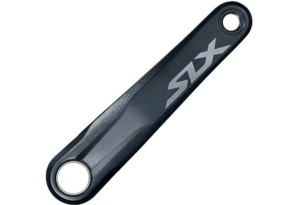
Weight: 646 gr
Material: Aluminum
Ring sizes: 30t, 32t, 34t
Arm lengths: 170, 175mm
Compatible components: Shimano XT, XTR and SLX
Shimano’s latest release of the popular SLX crankset brings a fair few updates that improve its performance and aesthetics. The most noticeable is that what has been the preferred choice for budget-strapped riders now also gets upgraded to 12-speed.
The hollow forged alloy cranks have been redesigned making use of Shimano’s own Hollowtech 2 technology, reducing a whooping 70 grams from the previous iteration. That’s just a handful of grams heavier than XT cranks!
The SHIMANO SLX M7100 comes off the self without a chainring, so you can choose your preferred teeth number from Shimano (30t, 32t, or 34t) or other aftermarket compatible suppliers. The rings are direct-mount and, as mentioned, its narrow teeth profile is compatible with 12 speed.
At the $150 price point, it’s hard to find a better value crankset for a 12-speed build. Its long-term durability is yet to be proven but the new SLX iteration looks promising.
Pros
- Lightweight
- Durable
- 12-speed
Cons
- Limited arm length options
2. SRAM SX Eagle DUB Crankset
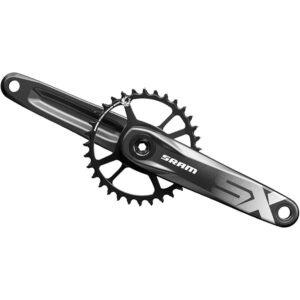
Weight: 773 gr
Material: Aluminum
Ring sizes: 30t, 32t, 34t
Arm lengths: 155, 165, 170, 175mm
Compatible components: SRAM Eagle range
A high-performing mountain bike crankset at just $100? That is the main strength of the SRAM SX Eagle DUB, along with an impressive stiffness and a very respectable weight.
Its proprietary X-SYNC 2 tooth design presents a very aggressive profile that feels smooth and improves chain retention even in rough terrain. It also proved to extend the chain lifespan.
It is compatible with 3 ring sizes (30t, 32t, and 34t) but also with a variety of aftermarket options, including oval rings. As the only downside, mention that its oversize DUB axle will force you to install a compatible SRAM bottom bracket on your bike.
All in all, it is hard to beat the stiffness-to-weight ratio of the SRAM SX Eagle DUB crankset at this price point. What’s even better, the latest iteration comes with an improved scratch-resistant finishing.
Pros
- Excellent price
- Stiffness
- Weight
Cons
- Limited compatibility
3. Truvativ Descendant Carbon DUB Crankset
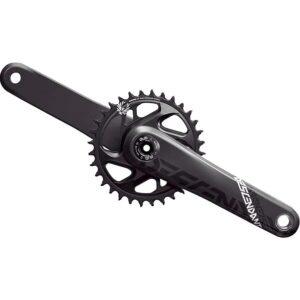
Weight: 549 gr
Material: Carbon
Ring sizes: 30t, 32t, 34t
Arm lengths: 165, 170, 175mm
Compatible components: SRAM Eagle range
Are you looking to shed a few grams from your Eagle groupset? The Truvativ Descendant Carbon DUB is one of the most affordable carbon upgrades that could help you with that.
Combining Truvativ’s proprietary carbon crank arms with the latest iteration of the DUB axle, it is fully compatible with all previous SRAM DUB bottom brackets, including English threaded, PF30, and BB30.
They are stiffer than similarly priced alloy cranks and they also resist very well the cosmetic damage caused by scratches.
With the same great chain retention as all SRAM chainrings, it comes with 3 teeth options (30t, 32t, and 34t) and it is compatible with all SRAM Eagle groupsets, from GX to XX1 (always using an Eagle chain).
If you want to improve your performance significantly without breaking the bank, The Truvativ Descendant Carbon DUB crankset not only will reduce around 100 grams from your previous alloy cranks, but also will give you unparalleled stiffness for out-of-the-saddle uphill efforts.
Pros
- Lightweight
- Stiff
Cons
- Only compatible with DUB BB’s
4. Shimano XTR FC-M9100 Crank Set

Weight: 595 gr
Material: Aluminum
Ring sizes: 30t, 32t, 34t, 36t, 38t
Arm lengths: 170, 175mm
Compatible components: Shimano XTR
A full-on XC racing crankset for those looking into marginal gains. The new Hollowtech II alloy technology is used in this top-of-the-range Shimano crankset to defy what was previously the limits of stiffness and lightweight.
The crank arms have direct mount chainrings (offered in 30t, 32t, 34t, 36t, and 38t) that allow swapping between 1x and 2x drivetrain setups, and are compatible with 12 speed Shimano chains. A special tooth profile improves chain retention and offers a smoother ride even in rough terrains.
With direct mount rings and tool-free preload adjustment, these are possibly the most simple, yet effective crank arms that the Japanese brand has ever designed. Their aesthetics are also pretty minimal, with a small XTR logo over a satin black background.
These might not be able to compete in weight with carbon cranksets but their stiffness and smooth shifting under heavy power loads make them the perfect racing tools (as chosen by many pro riders).
Pros
- Possible the best alloy cranks in the market
Cons
- Not cheap
5. ROTOR Rhawk Boost
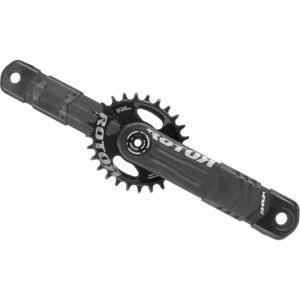
Weight: 665 gr
Material: Aluminum
Ring sizes: 26t, 28t, 30t, 32t, 34t
Arm lengths: 165, 170, 175mm
Compatible components: Rotor Qrings
A personal favorite, Spanish brand Rotor brings aluminum technology to its limit thanks to CNC machining, offering a lightweight alloy crankset that can compete with carbon models at a lower price point than those.
It includes Rotor’s signature oval Qrings, another innovation that the brand pioneered that gives you a smoother transition throughout the pedal stroke. The position of the ring can be adjusted to optimize the rider’s power output. It also includes crank protectors that make them bulletproof.
As a result of bringing these alloy cranks down to their lowest weight possible, Rotor made the Rhawk crank arms a little bit flexy but only when put under a maximum power effort. Apart from this detail, the crankset seems pretty reliable and it is undoubtedly one of the most aggressive-looking.
A beautifully designed and bomb-proof allow crankset that will favor riders with a higher cadence and less raw power.
Pros
- Wide variety of adjustment options
Cons
- A bit flexy
6. Race Face Next SL
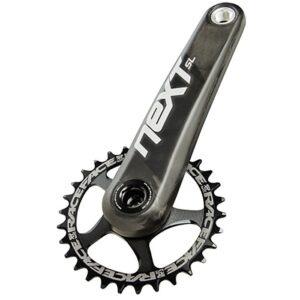
Weight: 441 gr
Material: Carbon
Ring sizes: 24t-42t
Arm lengths: 170, 175mm
Compatible components: –
Only with carbon fiber, a manufacturer could have achieved such a lightweight crankset with a tremendous stiffness-to-weight ratio. Race Face’s latest iteration of its top-of-the-range crank arms are the lightest of this list, but they don’t come cheap!
With a wide variety of ring options, from a tiny 24t up to 42t, and even compatibility for a double spider, the Next SL gives you plenty of room to nail down your favorite drivetrain setup. It is also compatible with tons of protector options and power meters.
A couple of misses would be the lack of a shorter crank arm option (165 mm) and the high retail price of $450 just for the crank arms. It surely is an investment well worth it when considering the possibility of shaving more than 300 grams from a stock drivetrain.
Pros
- Ultra-light
- Stiff
Cons
- Expensive
7. Hope Evo MTB Crankset
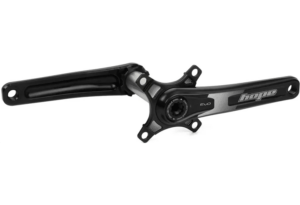
Weight: 563 gr
Material: Aluminum
Ring sizes: 32t, 34t, 36t
Arm lengths: 165, 170, 175mm
Compatible components: –
Lighter than you would expect from a medium-range aluminum crankset, this robust model from British-based Hope will not suffer from flex issues at all.
Not only are they tough but also so impeccably machined that the aesthetics will be another strong point when it comes to splashing a few more bucks in these cranks.
Although with a higher price tag than similarly specced cranksets, the Hope Evo features such a variety of arm lengths and color options (anodized in black, blue, red, silver, purple, and orange) that will certainly be competitive against cheaper brands.
On top of all these qualities, the Hope Evo crankset is easy to install and compatible with a wide variety of bottom bracket standards. They are not the cheapest aluminum model out there but they will give you a refined touch and great personalization options that are worth the trade.
Pros
- Impeccable alloy construction
- Color options
Cons
- Value for money
Buying Tips
Firstly, let’s tackle the question of whether you need a 1x or 2x drivetrain.
Single ring drivetrains have recently become the preferred choice for many brands. Thanks to the innovations that allow a wider range of gears with 12-speed groupsets, even the entry-level models are now equipped with a single chainring.
It is still possible to install double rings in many of the cranksets listed above but that’s an option I would discourage since it will make your bike heavier, more difficult to service, and overall will lower significantly the shifting performance. 1x modern technology just works perfectly for most riders’ needs, so there is no need to make things complicated again.
Chainring size
The next aspect you should consider is the chainring size and compatibility. For less powerful riders or super-steep terrain, I would recommend going for a 30t to make spinning easier.
Stronger riders on fast terrain will benefit from larger rings such as 36t. Oval rings are a good compromise for flatter terrain and still be able to climb decently.
Compatibility
When it comes to compatibility, there are several options of aftermarket chainrings that you can install on your MTB crankset but it will depend on how the rings are mounted to any specific crank arms.
Apart from the number of bolts (either 4 or 5) the main figure to watch out for here is the BCD (Bolt Circle Diameter). It will tell you straight away whether a ring is compatible with your crank arms.
Crank length
Now that you have your ring size it’s time to decide which crank length will suit you better. Longer crank arms will potentially give you more torque power (especially to taller riders) but are more likely to strike rocks or branches on difficult terrains that can lead to crashes.
It will also depend on the geometry of your bike and how high is the bottom bracket from the ground. As a general rule, I’d recommend going for 165 mm or 170 mm.
Bottom bracket compatibility
Another important factor when upgrading your crankset is bottom bracket compatibility. If you are keeping with the same brand, say Shimano or SRAM, but going for a higher specs model you won’t have much trouble with BB compatibility.
The problem is when you swap between brands, you will probably need to get a new bottom bracket, most likely from the brand you are upgrading to.
Material and aesthetics
On to the last two relevant factors: material and aesthetics. Firstly, I would only recommend opting for carbon cranks if you are racing or you are quite an experienced rider. Some aluminum models are almost as lightweight as carbon but much tougher and less prone to superficial damage.
I’m also a big advocate of aluminum thanks to its personalization properties: this is a material that can be chemically modified (anodized) to obtain gorgeous finishing in various colors, so you won’t need to stick to the classic matt black anymore.
On the other hand, while carbon has limited personalization options and it’s a more delicate and expensive material, it will offer much more stiffness than any other material available for the same weight. That’s crucial in competition when every watt matters, but for any other use I would stick to alloy components.

Road cyclist, adventure traveler and graphic designer based in South East Asia, and working for international brands such as SpiceRoads Cycling and The Pedla.


